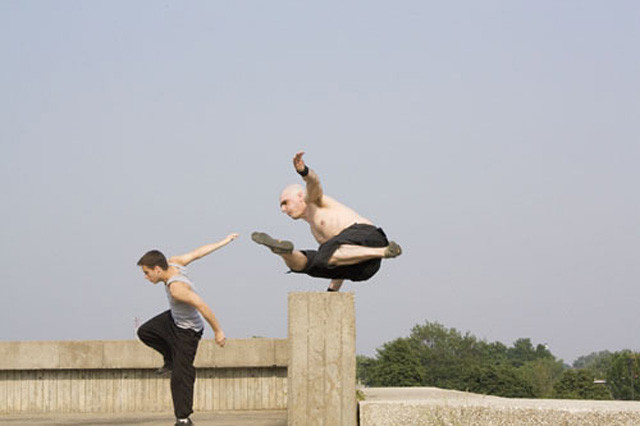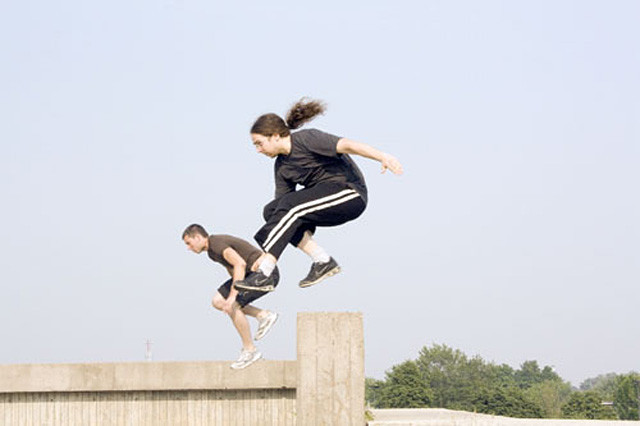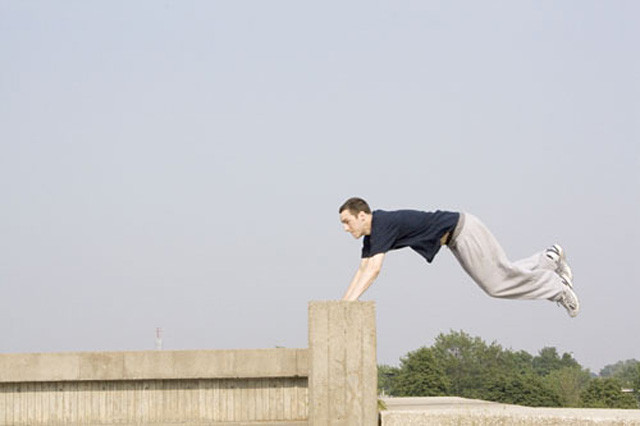Of leaps and bounds
The Olympic Park becomes prime real estate for parkour
At first glance, parkour may seem like simply an adrenaline junkie’s fix for random sprints, gravity-defying leaps and a lust for imminent danger. The l’art du déplacement, as the physical discipline is known in its native France, is actually an elaborate exercise of body displacement with the goal of getting from point A to B as quickly as possible.
“Parkour is just basically using your body and your environment as efficiently as possible to get around,” explained Jules Desmarais, a fiber arts student at Concordia and member of the Communauté du parkour au Québec. “Every day is different, every day is an adventure. I guess it’s the feeling of freedom I get when I do it.”
Desmarais is part of a Montreal-based group, that holds practices on Mondays, Wednesdays, and Saturdays at the Olympic Park. There are no fees and people of all abilities are welcome to participate.
Those who are acquainted with the sport often equate it with a sense of freedom, and ultimately, a lifestyle.
“The sport it could be most compared to would probably be a martial art. A non-competitive form [that is], which means you get to know yourself through your practise and better yourself,” said Desmarais.
George Hébert, a naval officer from the late 1800s, is credited with pioneering the discipline after noticing the advanced physical abilities of indigenous people in Africa and their strict reliance on nature to develop their skills.
As parkour owes most of its jargon to its French origins, practitioners call themselves traceurs, meaning “to trace or draw a line” in French and refers to the path used within one’s environment. The word is also slang for “to go fast,” as speed and efficiency define the practice.
Some of the terms used in parkour are: Saut de fond or drop, planche or muscle-up, roulade or roll, and passe muraille or wall hop/run. Although knowledge of the terminology is not necessary, it does increase one’s understanding of a discipline as broad in scope as parkour, if not to feel a sense of appropriation with other traceurs.
Parkour emphasizes camaraderie, benevolence, assistance, honor, and honesty, which are ideologies found within the natural method’s moral tenets. It is a minimalistic discipline, requiring no equipment other than shoes and the environment. There is a sense of unity between oneself and nature, according to participants, and traceurs stress the importance of non-competitiveness, believing that rivalry strips away the essence of self-development.
“The parkour community is a very friendly brotherhood where everyone is eager to help one another,” stated Steven Leblanc, an aspiring kinesiologist and instructor at PKQC. “When you start doing parkour, your vision of the environment changes—it’s about you and your body.”
Inspired by Luc Besson’s 2001 film, Yamikasi—Les samouraïs des temps modernes, Leblanc began practising parkour eight years ago and has been teaching it for the last two.
“People used to come to me for advice but I didn’t know how to explain it to them, so I had to theorize the movements in order to better explain,” he said.
Silex Kit, a female instructor at PKQC, was also inspired by Besson’s feature.
“I saw Yamikasi and did some research on the web and found a group that practised this sport in Montreal,” said Kit. “I was looking for a fun way to keep in shape and I wanted to try something new.”
Movies like Yamikasi show that parkour can become more than just a hobby and well-known stuntman David Belle is living proof of that.
Although the training is arduous, “it’s very simple,” said Kit. “You do it when and where you want to. You don’t realize that you’re working hard because you’re having fun.”
Coinciding with Hébert’s philosophy and motto “être fort pour être utile,” which means “be strong to be useful,” the lifestyle aspect of parkour is integral to the practice.
“You can run about the city and improvise with what you see, but always look before you leap,” said Desmarais.
This article originally appeared in Volume 31, Issue 1, published June 11, 2010.





1_600_375_90_s_c1.jpg)
2_600_375_90_s_c1.jpg)
_600_375_90_s_c1.JPG)